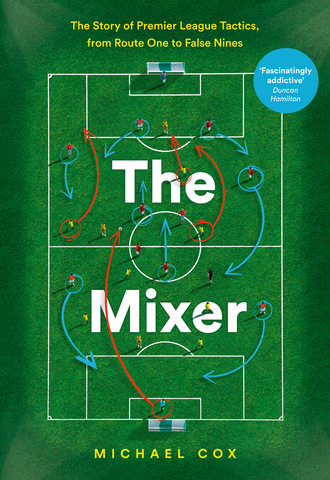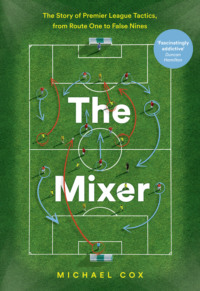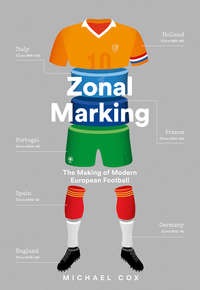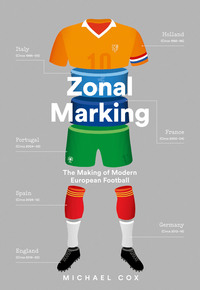
Полная версия
The Mixer: The Story of Premier League Tactics, from Route One to False Nines
The cause of Newcastle’s decline, however, was related to the addition of two signings in the New Year. Unpredictable Colombian forward Faustino Asprilla was signed on a snowy Friday in February, the day before Newcastle made the short trip to Middlesbrough. On matchday Keegan assured Asprilla he wouldn’t be playing, and at lunchtime poured him a glass of wine. But incredibly, the Colombian was introduced as a second-half substitute just hours later and created the equaliser for Watson almost immediately, bamboozling opposition centre-back Steve Vickers with a wonderful Cruyff turn before crossing. Watson pointed to Asprilla in celebration, and his teammates instinctively congratulated the assister rather than the goalscorer. Asprilla had provided Newcastle with a spark.
While his signing is sometimes blamed for Newcastle’s collapse, in the second half of the season Asprilla was Newcastle’s best player. He was fantastic in the unfortunate, and fatal, defeat to Manchester United, when the combination of Peter Schmeichel’s saves and Eric Cantona’s finish resulted in a barely deserved 1–0 win for the eventual champions. He was pivotal in the 3–0 victory over West Ham and was Newcastle’s best player in that 4–3 defeat to Liverpool, grabbing a goal and an assist. The problem, though, was that his arrival changed Newcastle’s shape entirely – and Keegan didn’t explain how he wanted his players to adjust. Asprilla was very different to Beardsley, who switched to an unfamiliar right-sided midfield role, and Ferdinand was left perplexed by the change, especially as Asprilla was immediately the main man. ‘I haven’t bought Asprilla to play with you, I’ve bought him for you to play with him,’ Keegan somewhat bluntly told Ferdinand. There were no attempts to get them on the same wavelength in training, and Keegan later told Ferdinand he simply needed to ‘expect the unexpected’ from Asprilla – a reasonable summary of his style, but hardly useful advice. Ferdinand, having been scoring at roughly a goal per game beforehand, now scored one in three.
The Colombian’s full debut coincided with Keegan’s surprise decision to switch from Newcastle’s usual 4–4–2 to a more flexible system often appearing like a 3–5–2 for a 2–0 defeat to West Ham and a hugely entertaining 3–3 draw at Manchester City. The biggest beneficiary was Albert, as the moustachioed Belgian centre-back was deployed as a sweeper with licence to burst forward. Against City he scored twice and created the other for Asprilla, all from open play, a perfect demonstration of how he was a footballing centre-back ahead of his time. Asprilla was Newcastle’s most dangerous attacking weapon in both games, but got away lightly with a one-match ban for elbowing and headbutting City centre-back Keith Curle. ‘He’s from Latin America, that’s the way they are,’ offered Keegan. That dominated the headlines, but the greater issue was that Newcastle’s lack of shape had never been more obvious. Newcastle won 43 per cent of matches with Asprilla, compared with 75 per cent without him.
For the next game, a 1–0 defeat to Manchester United, Newcastle returned to 4–4–2 but boasted another new signing: David Batty, the circumstances of whose arrival were peculiar. Sir John Hall, Newcastle’s chairman, wanted to sign a centre-back to improve Newcastle’s defence. Keegan was having none of that, however, so they compromised and bought a defensive midfielder, which doesn’t seem a particularly logical approach to recruitment. Even Batty was surprised. ‘They were flying at the top of the table and I couldn’t imagine why they’d want to change things,’ he admitted. Batty, a pure defensive midfielder, replaced the forward-thinking Clark, and once again, Newcastle attempted to play similar football with an entirely different player in a key position – the problem, of course, was the system rather than individuals. Batty slowed Newcastle’s passing and didn’t perform his defensive midfield role perfectly either – in the late-season 1–1 draw with Nottingham Forest, for example, Ian Woan dribbled past him easily before smashing into the top corner from 25 yards. Keegan considered Batty an excellent signing – although, typically, believed his long-term future was as a forward-thinking centre-back, bringing the ball forward from deep. Keegan’s logic was that this would allow him to play yet another attacking player in midfield. He simply couldn’t get enough.
Newcastle’s gung-ho approach was epitomised by that 4–3 defeat to Liverpool at Anfield in early April 1996, a game widely considered the Premier League’s greatest. It was an action-packed, end-to-end thriller, the goals starting in the 2nd minute and not ending until the 92nd. Newcastle led for the majority of the contest, both 2–1 and 3–2, but somehow conceded a late-minute winner to Stan Collymore, to leave Keegan slumped over the advertising hoardings.
Newcastle entered the game in disastrous form, having collected just seven points from their previous six matches. Keegan made one change, with Watson replacing Barton at right-back, probably linked to the fact Watson had already scored two winners that season against Liverpool, in the reverse league fixture and the League Cup.
The ludicrously open nature of the contest was summarised by the positioning of Ginola. Newcastle played a 4–4–2 system while Roy Evans’ Liverpool played 3–5–2, which meant an inevitable question about whether or not Ginola would track Liverpool’s right-wingback Jason McAteer. The answer was simple – he didn’t. This had both positive and negative consequences; after Robbie Fowler had opened the scoring and Les Ferdinand equalised, Ginola’s advanced positioning behind McAteer meant he streaked away on a counter-attack. Liverpool’s centre-backs played very narrow, and Ginola had the entire left flank to himself, finishing coolly.
In the second half, however, Liverpool exploited the space behind Ginola, in particular with Steve McManaman’s constant drifts to that flank. He crossed for Fowler to equalise and had another dangerous cross sliced just wide of the far post by Steve Howey. Newcastle raced down the other end and scored again through Asprilla, in part because Liverpool centre-back John Scales had dropped very deep to cope with Ginola’s advanced positioning, playing the Colombian onside. Liverpool soon equalised again with a right-wing cross – this time a beautiful curled ball by McAteer, with Ginola nowhere to be seen. 3–3, and arguably two goals at either end came from Ginola’s positioning. The final five minutes were even more open, after Evans boldly introduced veteran striker Ian Rush for left-wing-back Rob Jones, with Collymore moving left. After interplay between Rush and John Barnes in the centre, the ball was switched wide to Collymore, who smashed home the winner. Liverpool had won the game with the type of attacking gamble that Keegan greatly admired. Keegan loved contributing to such a legendary, attack-minded game. ‘After the match I turned to Terry Mac and said, “I know I should be disappointed, but I’m elated,”’ he later recalled.
Newcastle’s players gave various tactical explanations for their decline. Ferdinand was frustrated the attack was now built around Asprilla. Gillespie believed his omission meant Newcastle weren’t stretching the play properly, something Lee agreed with, as Beardsley wasn’t at home on the right. Goalkeeper Pavel Srníček suggested Batty upset the rhythm of the side, and also accepted that Newcastle were simply found out by better sides in the second half of the campaign. The experiment with Albert as a sweeper in a rough 3–5–2, meanwhile, lasted two games, cost Newcastle five points and was immediately abandoned. Ginola’s decline in the second half of the season was also significant; his defensive sluggishness was criticised, but it wouldn’t have been problematic had he contributed the attacking efficiency of earlier in the season.
More than anything else, however, Newcastle’s problem was their overall lack of cohesion, surely due to omitting any collective work on the training ground. Keegan’s threw together talented individuals and let them run free, which largely worked with a simple, old-fashioned 4–4–2 that everyone knew how to play. But this laissez-faire style proved problematic when Keegan suddenly switched shape, when he signed a different type of centre-forward and a different type of deep midfielder. Newcastle simply didn’t have any tactics; their approach was a consequence of the 11 players Keegan assembled on any particular day.
But while Newcastle ultimately fell short of winning the Premier League, it was unquestionably a glorious failure; the players remain heroes in the city, the team still admired across the country. Keegan’s achievement in taking Newcastle from the second tier to the brink of the title shouldn’t be underestimated, and while naivety may have cost Newcastle the title, the most pertinent story is that they came so close with such basic tactics, highlighting the primitive approach of most Premier League sides at this point.
The title was presented in the north-east – but at Middlesbrough, where Manchester United ended the season with a 3–0 victory. Keegan was magnanimous in defeat, immediately congratulating Manchester United and predicting they would be ‘fantastic representatives of the Premier League in the Champions League’ the following season. It recalled the way he’d referred to Asprilla, upon the Colombian’s arrival, as ‘a real asset to the Premier League – and Newcastle United, I hope’. Perhaps it was just semantics, but it’s difficult to imagine Ferguson, who cultivated an ‘us against the world’ approach, caring about the benefits to the league as a whole.
Newcastle responded to their failure in dramatic fashion, breaking the world transfer record to sign hometown boy Shearer from Blackburn. Keegan lasted just half of the following campaign before suddenly resigning, to be replaced by, inevitably, Dalglish. With Batty, Shearer and Dalglish, it was clear Newcastle were trying to be Blackburn – but tactically, the Premier League was already moving in a different direction.
Part Two
4
Between the Lines
‘Cantona’s supporters loved him, and so did the media. He was this foreign fella, different. Everyone wanted one like him, but it didn’t mean players like that grew on trees.’
Roy Evans
As Eric Cantona’s influence ensured Manchester United became the Premier League’s dominant force, other clubs desperately searched for their Cantona equivalent. A wave of talented, mercurial but often inconsistent number 10s joined the Premier League during the mid-1990s, with mixed success. England wasn’t producing players in that mould, so clubs looked abroad – often to relatively obscure footballing nations. Supporters of unglamorous, mid-table Premier League sides could now get excited by exotic, mysterious foreign deep-lying forwards whose presence was meant to inspire more aesthetically pleasing football.
Ipswich Town, for example, had Bulgarian Boncho Genchev, who opened his goalscoring account with a wonderful bicycle kick against Blackburn. He positioned himself between the lines to encourage passing football, but struggled to exert a consistent impact upon Premier League games. After a brief spell back home, he ended his career with a couple of spells at non-league Hendon, taking a break in between to run a short-lived Bulgarian café in Kensington called ‘Strikers’. Genchev himself wasn’t actually a striker, of course, although he was presumably comfortable in the serving role.
Southampton found the diminutive, extraordinarily gifted Israeli Eyal Berkovic, who featured decisively in the Saints’ famous 6–3 victory over Manchester United in 1996, his second league start. Berkovic enjoyed a successful Premier League career, although he is probably most famous for being booted in the head during a West Ham training session by teammate John Hartson.
Derby County signed Aljoša Asanović, a wonderful left-footed creator who played a significant part in Croatia’s journey to the Euro 96 quarter-finals and the 1998 World Cup semi-finals, and who is quite possibly the most underrated Premier League player. Unsurprisingly, he insisted on taking the number 10 shirt. Coventry City signed Moroccan Mustapha Hadji, a direct dribbler with a fine passing range, and he also took number 10. At West Ham, Harry Redknapp signed the Premier League’s first two Portuguese players – first Dani, then Paulo Futre. To Futre’s disgust, he wasn’t handed the number 10 shirt.
Ahead of his first game against Arsenal, West Ham’s kitman Eddie Gillam handed Futre the number 16 shirt, and promptly had it thrown back in his face. Not understanding that the Premier League had switched to permanent squad numbers that were consistent throughout the season and that number 10 had already been allocated to John Moncur, Futre shouted at Redknapp, ‘Futre 10, not 16! Eusebio 10! Maradona 10! Pelé 10! Futre 10! Not fucking 16!’ Redknapp told Futre to either wear the number 16 shirt or go home. So Futre went home. He later insisted the number 10 shirt was written into his contract, and when Redknapp pretended West Ham’s club shop had shifted so many shirts with Futre’s name and ‘16’ on the back that they couldn’t change it, Futre offered to refund any disappointed supporters up to a total cost of £100,000. Eventually West Ham sought permission from the Premier League for Moncur to change numbers, allowing Futre to wear 10; he thanked Moncur by allowing him a fortnight’s stay in his holiday villa on the Algarve. It’s surprising something similar didn’t happen at Sheffield Wednesday a couple of years later – two brilliant Italians, Benito Carbone and Paolo Di Canio, had serious claims to the number 10 shirt, but were forced to wear 8 and 11 respectively, with their favoured number taken by the somewhat less spectacular Andy Booth.
During this period, a relatively limited number of games were broadcast live on TV, while Match of the Day showed extended highlights from only a couple of big matches, screening just goals and major incidents from others. These players’ subtle, constant influence upon matches was therefore not overwhelmingly obvious to the majority of supporters, so they needed to provide concise summaries of their quality with outstanding individual moments.
Between November 1996 and August 1997 the BBC’s Goal of the Month competition was won by Dennis Bergkamp, Eric Cantona, Trevor Sinclair, Gianfranco Zola, Juninho, Zola again, Juninho again, then Bergkamp again – who, ludicrously, finished 1st, 2nd and 3rd that month. Sinclair’s famous bicycle kick aside, the Premier League’s greatest moments were being provided almost exclusively by four magical foreign playmakers: Cantona, Bergkamp, Zola and Juninho. These players fundamentally changed their clubs’ footballing style, but required their sides to be built entirely around them. This proved problematic. Depending upon a newcomer to English football was risky, especially when foreign imports were still a relatively recent phenomenon and clubs did extremely little to help them settle.
If Cantona was the trailblazer, Bergkamp and Zola followed closely behind in his slipstream. They weren’t, however, joining title challengers; Arsenal had finished in the bottom half of the Premier League immediately before signing Bergkamp in the summer of 1995, as had Chelsea just before their purchase of Zola the following year. Like Cantona, both players had an immediately positive effect on their teams, and the fact that Manchester United, Arsenal and Chelsea have been the three most successful clubs in the Premier League era can, in part, be traced back to the arrival of these three brilliant deep-lying forwards.
Bergkamp and Zola were unquestionably top-class footballers. Bergkamp had finished second in the 1993 Ballon d’Or, one place ahead of Cantona and behind only Roberto Baggio, the greatest number 10 of this generation. Meanwhile, Zola finished sixth in 1995. They were revered across Europe because of their creativity, their selflessness and the spatial awareness that allowed them to thrive between the lines. Both arrived from Serie A, with Bergkamp – whose influence upon Arsenal would become clear later on – outlining why he discovered the Premier League suited him. ‘English defences always played a back four, with one line, which meant they had to defend the space behind. In Italy they had the libero [a sweeper who would cover behind his fellow defenders], but the English had two central defenders against two strikers, so they couldn’t really cover each other. As an attacker I liked that because it meant you could play in between the lines. They couldn’t come off their line. So I used that.’
Zola discovered something similar. ‘At the beginning, the open English football really helped me, as I was coming from tighter marking in Serie A,’ he explained. Zola only arrived in England because his former club, Parma, had an inflexible coach who was unwilling to deviate from 4–4–2. Surprisingly, this was Carlo Ancelotti, who would later become the go-to manager for continental giants awash with superstars – including Chelsea – precisely because he was flexible enough to build teams around star individuals. Back then, however, Ancelotti – who had been Italy’s assistant coach under legendary manager Arrigo Sacchi, the man who popularised a pressing 4–4–2 system – simply wouldn’t accommodate a number 10, turning down Baggio for similar reasons, and attempted to play Zola out wide. ‘I will be able to play my proper role in England,’ Zola declared upon his arrival in London.
Zola had served his apprenticeship at Napoli under the best possible mentor. ‘I learned everything from Diego Maradona,’ he admitted. While famous for his ego, Maradona was also renowned for being extremely generous with his praise of his Napoli teammates, and he loved Zola so much that, ahead of a Coppa Italia tie against Pisa, he handed the Sardinian his famous number 10 shirt, and wore number 9 instead. Zola was forced to settle for 25 at Chelsea, with Mark Hughes in his favoured 10 shirt, but it became an iconic number. Although not officially retired by Chelsea, no one has dared to wear Zola’s number 25 since his departure in 2003.
Zola’s technical ability was outstanding. His first goal was a magnificent free-kick in a 2–2 draw with Everton, and only David Beckham has scored more Premier League free-kicks. Zola confirmed his status as Chelsea’s dead-ball specialist after a training-ground competition with Dennis Wise. A sock was tied to the crossbar – both were five foot six, so this presumably involved one sitting on the other’s shoulders – and they stood outside the box and attempted to curl the ball against the sock. Zola won 10–1, and the matter was settled. Dismayed by the lack of equipment at Chelsea’s old training ground near Heathrow Airport, Zola purchased his own mock defensive wall and spent hours practising.
While Cantona was tall and physically commanding, Zola was small, slight and wore size 5 boots. He was strong for his size, however, and used his body excellently. Chelsea teammate Graeme Le Saux considered him the joint best forward he’d ever seen, along with Kenny Dalglish, at the art of shielding the ball from defenders. But more than anyone else of this era, Zola thrived upon space, a classic example being his winner in the 1997 FA Cup semi-final against Wimbledon at Highbury. Initially positioned high up against the opposition defence, Zola watched teammate Roberto Di Matteo moving between the lines, dragging Wimbledon’s right-sided centre-back Chris Perry up the pitch. Zola then sprinted into the space Perry had vacated, pulling Wimbledon’s left-sided centre-back Dean Blackwell across to cover. Di Matteo played the ball into Zola’s feet, and Chelsea’s number 25 immediately backheeled it into the zone Blackwell had vacated, changed direction, collected the ball and fired home. In a few seconds, he’d seen space, exploited it, created more space, exploited that, and scored. For a player in his mould, it was the perfect goal.
Crucially, Zola was allowed a ‘free role’ behind the main striker, in a Chelsea side formatted specifically to bring out his qualities. Centre-back Steve Clarke remembers a team talk in which the message was simply ‘get the ball to Zola’, while Wise referred to Zola as a ‘showhorse’ and labelled himself a ‘donkey’. The donkey’s job, he said, was simply to do the hard work and pass to the showhorse. ‘Historically [English sides] have been set up with two strong strikers, two sitting midfielders and two wingers,’ Zola said after his retirement. ‘You never used to play the ball through the middle. What you used to do was play the ball down the sides and cross the ball to the tall player.’ Zola, like Cantona and Bergkamp, helped to change that.
‘He’s a clever little bugger … a better player than I thought he was,’ Alex Ferguson had conceded two months earlier, after Zola scored a fine second-minute goal against Manchester United, dribbling inside from the right before finishing with his left foot. ‘I thought we could push my full-backs forward, but he was smart enough to go and play wide. He has got a good head on him.’ Later, Ryan Giggs claimed that such was Zola’s ability to find space that he was the only Premier League player United man-marked, although this often proved unsuccessful. For Chelsea’s 5–0 thrashing of United in October 1999, Ferguson was without Giggs and played Phil Neville in his place, but instructed him to play centrally, man-marking Zola. United largely nullified the Italian but left a gaping hole on their left, which meant Chelsea’s Albert Ferrer and Dan Petrescu, two right-backs in tandem, assisted the opening two goals with deep crosses.
While Premier League observers marvelled at these majestic, game-changing foreign number 10s, there was nevertheless an acknowledgement that many arrived in Britain because they had limited options elsewhere. Cantona had effectively been run out of France, Bergkamp struggled in Italy with Inter Milan, while Zola had recently turned 30, then considered the cut-off for forwards’ peak years, and admitted he only expected to play for a couple more seasons. There was a sense that the Premier League was gaining top-class players when they were on the way down. Therefore, in one respect the most significant arrival during this period was another foreign number 10: Juninho. Newly promoted Middlesbrough’s purchase of the diminutive Brazilian in 1995 was a truly remarkable transfer coup, because he was unquestionably on the way up.
Juninho had impressed on English soil that summer, when world champions Brazil competed alongside England, Sweden and Japan in the Umbro Cup, a tournament held as preparation for the following summer’s European Championships. Juninho wore Brazil’s number 10, the most iconic shirt in world football, played in a 4–3–1–2 system based around him and was inspirational in the 3–1 victory over England. He opened the scoring with a classic Brazilian ‘folha seca’ (dry leaf) free-kick, played with topspin, which surprised goalkeeper Tim Flowers with its sudden dip. Simply being allowed to take free-kicks ahead of Roberto Carlos was an achievement in itself. Brazil’s second goal, meanwhile, showcased Juninho’s playmaking skills perfectly; he received the ball between the lines, glanced up and sidefooted a through-ball into the path of another promising youngster, Brazil’s number 9, who finished confidently by rounding Flowers and converting into an empty net. It was English football’s introduction to Ronaldo, and yet everyone was talking about Juninho.
In the home dugout at Wembley that sunny afternoon was Bryan Robson, then acting as assistant to England manager Terry Venables in addition to his role as player-manager of Middlesbrough. Mesmerised by the opposition number 10’s performance, Robson convinced Middlesbrough’s board to sign Juninho, beating the likes of Arsenal, Inter and Porto to the Brazilian’s signature. Middlesbrough chief executive Keith Lamb referred to his new recruit as ‘the most sought-after player in the world’. Hyperbole, certainly, and somewhat undermined by the fact that Juninho cost less than Middlesbrough’s other major arrival that summer, Nicky Barmby, but this was a landmark purchase, a rising player joining a rising team in a rising league.








